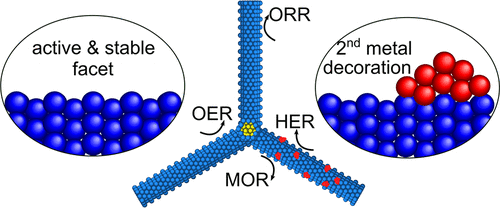当前位置:
X-MOL 学术
›
Acc. Chem. Res.
›
论文详情
Our official English website, www.x-mol.net, welcomes your feedback! (Note: you will need to create a separate account there.)
Synthetic Strategies to Enhance the Electrocatalytic Properties of Branched Metal Nanoparticles
Accounts of Chemical Research ( IF 18.3 ) Pub Date : 2022-05-26 , DOI: 10.1021/acs.accounts.2c00140 Agus R Poerwoprajitno 1 , Soshan Cheong , Lucy Gloag 1 , J Justin Gooding 1 , Richard D Tilley 1
Accounts of Chemical Research ( IF 18.3 ) Pub Date : 2022-05-26 , DOI: 10.1021/acs.accounts.2c00140 Agus R Poerwoprajitno 1 , Soshan Cheong , Lucy Gloag 1 , J Justin Gooding 1 , Richard D Tilley 1
Affiliation

|
Branched metal nanoparticles have unique catalytic properties because of their high surface area with multiple branches arranged in an open 3D structure that can interact with reacting species and tailorable branch surfaces that can maximize the exposure of desired catalytically active crystal facets. These exceptional properties have led to the exploration of the roles of branch structural features ranging from the number and dimensions of branches at the larger scales to the atomic-scale arrangement of atoms on precise crystal facets. The fundamental significance of how larger-scale branch structural features and atomic-scale surface faceting influence and control the catalytic properties has been at the forefront of the design of branched nanoparticles for catalysis. Current synthetic advances have enabled the formation of branched nanoparticles with an unprecedented degree of control over structural features down to the atomic scale, which have unlocked opportunities to make improved nanoparticle catalysts. These catalysts have high surface areas with controlled size and surface facets for achieving exceedingly high activity and stability. The synthetic advancement has recently led to the use of branched nanoparticles as ideal substrates that can be decorated with a second active metal in the form of islands and single atoms. These decorated branched nanoparticles have new and highly effective catalytic active sites where both branch metal and decorating metal play essential roles during catalysis.
中文翻译:

增强支链金属纳米粒子电催化性能的合成策略
支链金属纳米颗粒具有独特的催化性能,因为它们具有高表面积,多个支链以开放的 3D 结构排列,可以与反应物质相互作用,并且可定制的支链表面可以最大限度地暴露所需的催化活性晶面。这些特殊的性质导致了对分支结构特征的作用的探索,从更大规模的分支的数量和尺寸到原子在精确晶面上的原子级排列。大规模分支结构特征和原子级表面刻面如何影响和控制催化性能的基本意义一直处于设计用于催化的分支纳米粒子的最前沿。当前的合成进展已经使支链纳米粒子的形成成为可能,其对结构特征的控制程度达到了原子尺度,这为制造改进的纳米粒子催化剂提供了机会。这些催化剂具有高表面积、可控尺寸和表面刻面,可实现极高的活性和稳定性。合成的进步最近导致使用支链纳米粒子作为理想的基材,可以用岛屿和单原子形式的第二种活性金属进行装饰。这些修饰的支链纳米粒子具有新的高效催化活性位点,其中支链金属和修饰金属在催化过程中都发挥着重要作用。这为制造改进的纳米颗粒催化剂提供了机会。这些催化剂具有高表面积、可控尺寸和表面刻面,可实现极高的活性和稳定性。合成的进步最近导致使用支链纳米粒子作为理想的基材,可以用岛屿和单原子形式的第二种活性金属进行装饰。这些修饰的支链纳米粒子具有新的高效催化活性位点,其中支链金属和修饰金属在催化过程中都发挥着重要作用。这为制造改进的纳米颗粒催化剂提供了机会。这些催化剂具有高表面积、可控尺寸和表面刻面,可实现极高的活性和稳定性。合成的进步最近导致使用支链纳米粒子作为理想的基材,可以用岛屿和单原子形式的第二种活性金属进行装饰。这些修饰的支链纳米粒子具有新的高效催化活性位点,其中支链金属和修饰金属在催化过程中都发挥着重要作用。合成的进步最近导致使用支链纳米粒子作为理想的基底,可以用岛和单原子形式的第二种活性金属进行装饰。这些修饰的支链纳米粒子具有新的高效催化活性位点,其中支链金属和修饰金属在催化过程中都发挥着重要作用。合成的进步最近导致使用支链纳米粒子作为理想的基材,可以用岛屿和单原子形式的第二种活性金属进行装饰。这些修饰的支链纳米粒子具有新的高效催化活性位点,其中支链金属和修饰金属在催化过程中都发挥着重要作用。
更新日期:2022-05-26
中文翻译:

增强支链金属纳米粒子电催化性能的合成策略
支链金属纳米颗粒具有独特的催化性能,因为它们具有高表面积,多个支链以开放的 3D 结构排列,可以与反应物质相互作用,并且可定制的支链表面可以最大限度地暴露所需的催化活性晶面。这些特殊的性质导致了对分支结构特征的作用的探索,从更大规模的分支的数量和尺寸到原子在精确晶面上的原子级排列。大规模分支结构特征和原子级表面刻面如何影响和控制催化性能的基本意义一直处于设计用于催化的分支纳米粒子的最前沿。当前的合成进展已经使支链纳米粒子的形成成为可能,其对结构特征的控制程度达到了原子尺度,这为制造改进的纳米粒子催化剂提供了机会。这些催化剂具有高表面积、可控尺寸和表面刻面,可实现极高的活性和稳定性。合成的进步最近导致使用支链纳米粒子作为理想的基材,可以用岛屿和单原子形式的第二种活性金属进行装饰。这些修饰的支链纳米粒子具有新的高效催化活性位点,其中支链金属和修饰金属在催化过程中都发挥着重要作用。这为制造改进的纳米颗粒催化剂提供了机会。这些催化剂具有高表面积、可控尺寸和表面刻面,可实现极高的活性和稳定性。合成的进步最近导致使用支链纳米粒子作为理想的基材,可以用岛屿和单原子形式的第二种活性金属进行装饰。这些修饰的支链纳米粒子具有新的高效催化活性位点,其中支链金属和修饰金属在催化过程中都发挥着重要作用。这为制造改进的纳米颗粒催化剂提供了机会。这些催化剂具有高表面积、可控尺寸和表面刻面,可实现极高的活性和稳定性。合成的进步最近导致使用支链纳米粒子作为理想的基材,可以用岛屿和单原子形式的第二种活性金属进行装饰。这些修饰的支链纳米粒子具有新的高效催化活性位点,其中支链金属和修饰金属在催化过程中都发挥着重要作用。合成的进步最近导致使用支链纳米粒子作为理想的基底,可以用岛和单原子形式的第二种活性金属进行装饰。这些修饰的支链纳米粒子具有新的高效催化活性位点,其中支链金属和修饰金属在催化过程中都发挥着重要作用。合成的进步最近导致使用支链纳米粒子作为理想的基材,可以用岛屿和单原子形式的第二种活性金属进行装饰。这些修饰的支链纳米粒子具有新的高效催化活性位点,其中支链金属和修饰金属在催化过程中都发挥着重要作用。


























 京公网安备 11010802027423号
京公网安备 11010802027423号